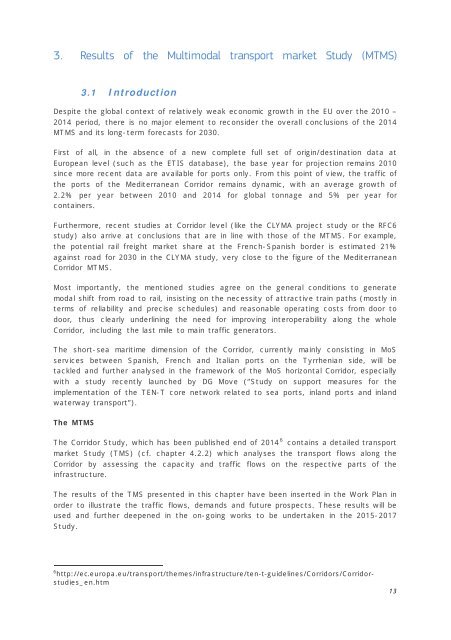Mediterranean
5Lwz6ndOG
5Lwz6ndOG
Create successful ePaper yourself
Turn your PDF publications into a flip-book with our unique Google optimized e-Paper software.
3. Results of the Multimodal transport market Study (MTMS)<br />
3.1 Introduction<br />
Despite the global context of relatively weak economic growth in the EU over the 2010 –<br />
2014 period, there is no major element to reconsider the overall conclusions of the 2014<br />
MTMS and its long-t erm forecasts for 2030.<br />
First of all, in the absence of a new complete full set of origin/destination data at<br />
European level (such as the ETIS database), the base year for projection remains 2010<br />
since more recent data are available for ports only. From this point of view, the traffic of<br />
the ports of the <strong>Mediterranean</strong> Corridor remains dynamic , with an average growth of<br />
2.2% per year between 2010 and 2014 for global tonnage and 5% per year for<br />
containers.<br />
Furthermore, recent studies at Corridor level (like the CLYMA project study or the RFC6<br />
study) also arrive at conclusions that are in line with those of the MTMS. For example,<br />
the potential rail freight market share at the French-Spanish border is estimated 21%<br />
against road for 2030 in the CLYMA study, very close to the figure of the <strong>Mediterranean</strong><br />
Corridor MTMS.<br />
Most importantly, the mentioned studies agree on the general conditions to generate<br />
modal shift from road to rail, insisting on the necessity of attractive train paths (mostly in<br />
t erms of reliability and precise schedules) and reasonable operating costs from door to<br />
door, thus clearly underlining the need for improving interoperability along the whole<br />
Corridor, including the last mile to main traffic generators.<br />
The short-sea maritime dimension of the Corridor, currently mainly consisting in MoS<br />
services between Spanish, French and Italian ports on the Tyrrhenian side, will be<br />
tackled and further analysed in the framework of the MoS horizontal Corridor, especially<br />
with a study recently launched by DG Move (“Study on support measures for the<br />
implementation of the TEN-T core network related to sea ports, inland ports and inland<br />
waterway transport”).<br />
The MTMS<br />
The Corridor Study, which has been published end of 2014 6 contains a detailed transport<br />
market Study (TMS) (cf. chapter 4.2.2) which analyses the transport flows along the<br />
Corridor by assessing the capacity and traffic flows on the respective parts of the<br />
infrastructure.<br />
The results of the TMS presented in this chapter have been inserted in the Work Plan in<br />
order to illustrate the traffic flows, demands and future prospects. These results will be<br />
used and further deepened in the on-going works to be undertaken in the 2015-2017<br />
Study.<br />
6 http://ec.europa.eu/transport/themes/infrastructure/ten-t-guidelines/Corridors/Corridorstudies_en.htm<br />
13



